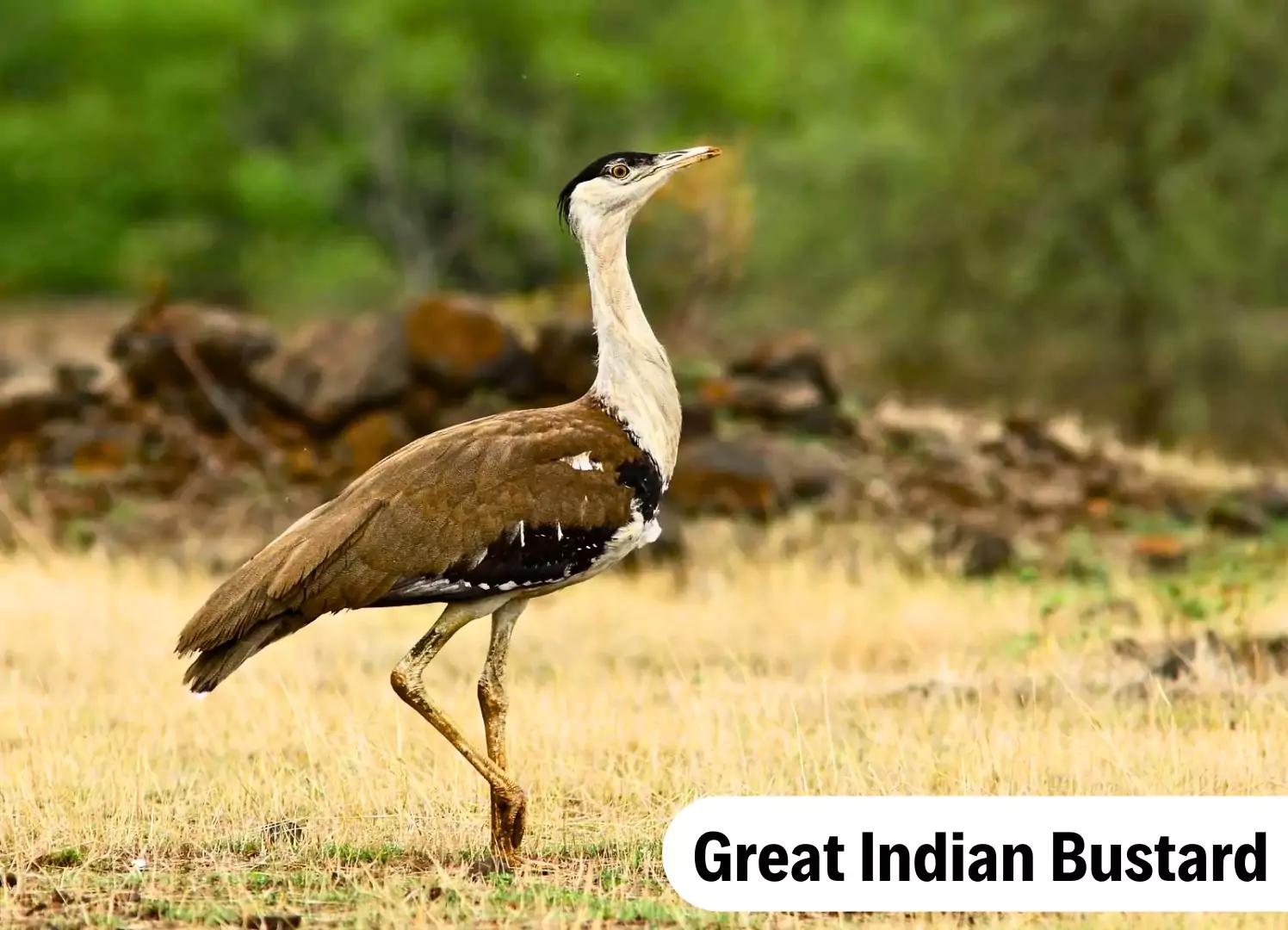Recently, the Ministry of Environment, Forest and Climate Change (MoEFCC) has approved Rs 56 crore for the next phase of the conservation of Great Indian Bustard (GIB) and Lesser Florican.
- As of now, around 140 GIBs and fewer than 1,000 Lesser Floricans are surviving in the wild.
Conservation Programme
- It has been running since 2016 for long-term recovery of critically endangered GIB and Lesser Florican.
Rewilding
- It aims to restore ecosystems and reverse biodiversity declines by allowing wildlife and natural processes to reclaim areas no longer under human management.
|
- Components of programme:
- First component: It comprises targets such as completion of the conservation breeding centre (CBC) in Jaisalmer’s Ramdevra, development of the Sorsan Lesser Florican facility, preparatory work for releasing captive-bred birds, release of GIBs in Rajasthan and other range states, post-release monitoring and artificial insemination.
- Second component: It comprises in-situ conservation of GIBs in other range states such as Gujarat, Maharashtra, Karnataka, Andhra Pradesh and Madhya Pradesh.
Enroll now for UPSC Online Course
Artificial insemination
It is the technique in which semen with living sperms is collected from the male and introduced into the female reproductive tract at proper time with the help of instruments. |
-
-
- This component will be implemented by Wildlife Institute of India (WII) along with state governments. Between 2024-2026: Wildlife Institute of India (WII) will also undertake GIB population estimation in Jaisalmer, its range states and rangewide population estimation of the lesser florican.
- Rewilding won’t begin before 2027: Until then WII plans to collect two to four eggs of the GIB and six to ten eggs of Lesser Florican each year.
- Captive-bred Bustards: Release sites will be identified. These Bustards will be trained for release and soft release enclosures will also be developed.
- 2024-2029 Phase: This will also target developing and implementation of artificial insemination techniques as a back-up to the captive-breeding conservation, scientists working on the project said.
- The WII has been collaborating with the Abu Dhabi-based International Fund for Houbara Conservation for the same.
About Great Indian Bustard

- GIBs are the largest among the four-bustard species found in India.
- The other three being
- MacQueen’s bustard
- Lesser florican
- Bengal florican
- Conservation Status:
- International Union for Conservation of Nature Red List (IUCN): Critically Endangered
- Convention on International Trade in Endangered Species of Wild Fauna and Flora (CITES): Appendix1
- Convention on Migratory Species (CMS): Appendix I
- Wildlife (Protection) Act, 1972: Schedule I
- Great Indian Bustard is the state bird of Rajasthan.
- Habitat: Today, its population is confined mostly to Rajasthan and Gujarat. Small populations occur in Maharashtra, Karnataka and Andhra Pradesh.
- Significance: GIBs are considered the flagship bird species of grassland and hence barometers of the health of grassland ecosystems
- Characteristics:
- Great Indian bustards are tall birds with long legs and long necks; the tallest individuals may stand up to 1.2 metres (4 feet) high.
- Males and females are distinguished by the colour of their feathers.
- Lifespan: 12-15 years
- GIBs are a slow-reproducing species: They lay a few eggs and have almost a year-long parental care of chicks. The GIB achieves maturity in around 3-4 years.
- Food Habits: Great Indian bustards are omnivores. They prey on grass seeds, insects l, and sometimes even small rodents and reptiles.
- Threat: Due to their poor frontal vision, the birds can’t spot overhead power lines from a distance, and are too heavy to change course when close.
- Thus, they collide with the cables and die.
- Recently, the Supreme Court constituted a seven-member committee to find a balance between conservation measures for the Great Indian Bustard (GIB) and efforts to generate renewable energy in the same regions.
Check Out UPSC Modules From PW Store
About Lesser Florican
Lesser Florican (Sypheotides indicus), often referred to as the likh or kharmore, is the smallest bustard Endemism: It’s endemic to the Indian Subcontinent, where it lives in tall grasses
- Conservation status:
- Wildlife Protection Act,1972: Schedule I
- CITES: Appendix II
- Mating Strategy: The most characteristic feature of the bird is the mating strategy.
- During the breeding season, males are seen folding their legs and leaping upwards, reaching a height of about 2 to 3 metres.
- They flutter rapidly, even up to 600 times a day, while emitting a croak-like sound.
- Habitat: States of Rajasthan, Gujarat, Madhya Pradesh, and parts of Andhra Pradesh, Maharashtra, and Karnataka.
Steps Taken to Protect
- 2013-2016: Plans to recover the species first started in 2013 under the National Bustard Recovery Plan, which later gave way to the Bustard Recovery Project in 2016.
- In July 2018: A tripartite agreement was signed between MoEFCC, Rajasthan forest department and WII.
- As part of the project run by the three parties, two GIB conservation breeding centres and one Lesser Florican centre are functioning in Rajasthan’s Sam, Ramdevra and Sorsan respectively.
- Project Great Indian Bustard: It has been launched by the Rajasthan government with an aim of constructing breeding enclosures for the species.
- GIB species recovery programme: Under this, the Wildlife Institute of India and Rajasthan forest department jointly set up breeding centers where GIB eggs harvested from the wild were incubated artificially.
- The Supreme Court is also monitoring the GIB and Lesser Florican conservation programme: A petition seeking protection of the two species is pending before it.
- Earlier, the SC had ordered burying power transmission lines in GIB habitat in Rajasthan and Gujarat in 2021
- However, it recalled its order in 2024 after the Centre submitted that the exercise would be expensive and impractical.
- The SC also tasked an expert committee to study the issue.
Enroll now for UPSC Online Classes
![]() 2 Jul 2024
2 Jul 2024

